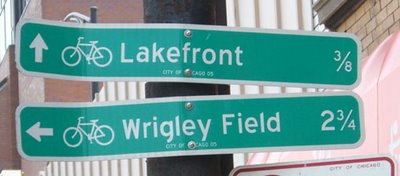Our foul-weather city
and a little jealousy from NYC

Over at StreetsBlog, Aaron Naparstek comments on a recent Governing Magazine article about how cities around the US are gearing up to make it safer and easier for commuters to bicycle to work. He's a bit miffed that Chicago seems to be doing more than his own NYC. Here are some excerpts from the article.
...when the subject is “bicycle commuting,” Chicago is not the first city that springs to mind. But it’s becoming a hot bike-to-work town. In the next decade, it plans to expand its network of bike trails to 500 miles, and has set a goal of putting a bike path of some sort within half a mile of every city resident.
Chicago’s new $3 million downtown bike station was paid for with federal funds and is now privately run. The transportation bill approved by Congress last year included about $4.5 billion for pedestrian and cycling projects — a 35 percent jump from previous spending levels. In many cases, bicycling improvement projects, particularly those that spruce up neighborhoods or provide safe routes to schools, qualify for Community Development Block Grants.
One hundred miles of dedicated bike lanes circle the city, capped off by the popular 20-mile Lakefront Path that runs almost the entire length of the city’s Lake Michigan shoreline. The new bike station downtown in Millennium Park, a multi-level, 12,000-square-foot facility, houses lockers, showers and a repair shop, plus 24-hour bike storage. Membership at the station costs $99 per year, but anyone can park bikes there for free. Last year, the city’s Parks Department established a “bike ambassadors” program. Its mission is to organize teams of teenage volunteers to educate commuters about bicycle safety.
Then, this summer, Chicago released its master bicycling plan, which it calls Bike 2015. The culmination of three years of study, the plan commits the city to a goal, less than a decade from now, of having 5 percent of all trips covering less than 5 miles made by bicycle. It pledges to cut the number of bike injuries in half. Thousands of new short- and long-term bike storage facilities are planned for locations all over the city. Many schools and transit stations would have dedicated bike lanes leading straight to the front door.
Chicago is a city where [Mayor Richard M. Daley] usually gets what he wants, and bicycles, along with health and environmental improvements, have been a near-obsession for Daley over the past several years.
The biggest lesson for cities ... is that a successful bike-commuting policy is a combination of infrastructure, education and promotion. While cities must build the right facilities — bikeways, storage, parking — they also must help cyclists gain the skills and confidence to ride in traffic. Efforts in that direction may include bike route maps, for example, or the bike ambassadors that Chicago has been trying. Combining these elements ... is key. The places that have been successful at this have done much more than just add bike lanes.
Labels: Chicago, Our Bike Mayor







0 Comments:
Post a Comment
<< Home